Competition, antagonism and play
Learning how to behave in different contexts means surviving
In situations of forced sociability, even animals considered “asocial” such as bears can behave very flexibly, adopting tactics to reduce any tension.
Between the end of July and beginning of August, the bears in the Park face a sudden change. They move from a rather solitary life to a more social one. This happens on the high altitude scree, covered with alpine buckthorn bushes, loaded at this time of year with fleshy, nutritious berries, an irresistible attraction for the bears. But the alpine buckthorn scrub covers a greatly fragmented area of just 16 km2. So in order to take advantage of this nutritious and easy food concentrated in a small space, bears inevitably risk “treading on each other’s toes”. Summer also coincides with the onset of hyperphagia, the period when bears accumulate fat in preparation for winter and need to consume up to 20,000 Kcal per day. For females, this also means ensuring the development and birth of their cubs. The bears therefore face a difficult dilemma: on one hand they have at their disposal an abundant and inexpensive meal (just the effort of moving from bush to bush), while on the other, they are more at risk of exposure to possible violence from other bears. How to behave? Which to choose?
Bears show an amazing ability to adapt and are able to reduce the tensions that may arise from the close presence of other members of the same species.
So in contexts of forced close co-existence, such as the famous salmon runs in the rivers of Alaska, bears do, yes, have more opportunities for interacting between individuals, but they do so in an unexpectedly non-aggressive way. The calm is more than just apparent, as when the levels of the so-called “stress” hormone, cortisol, were measured in the animals’ blood, the values were found to be low. In these situations, bears remain apparently calm and cool-headed. Bears are also creatures of habit and seem to stick to the same feeding areas year after year. According to researchers, this familiarity helps the bears study and thus get to know each other over the years, so they know when and how to move to minimise interactions. This is why confrontations usually take place at a distance and apparently peacefully. Bears may, in fact, be able to establish hierarchies that ensure everyone has a place and time to feed.
This also seems to occur in the Park’s alpine buckthorn scrub. With the exception of the breeding season and family groups, summer is the only period when several bears can be observed in the Apennines interacting together. These are the only areas where it is possible to witness the amazing behavioural repertoire bears have at their disposal to cope with their social life.
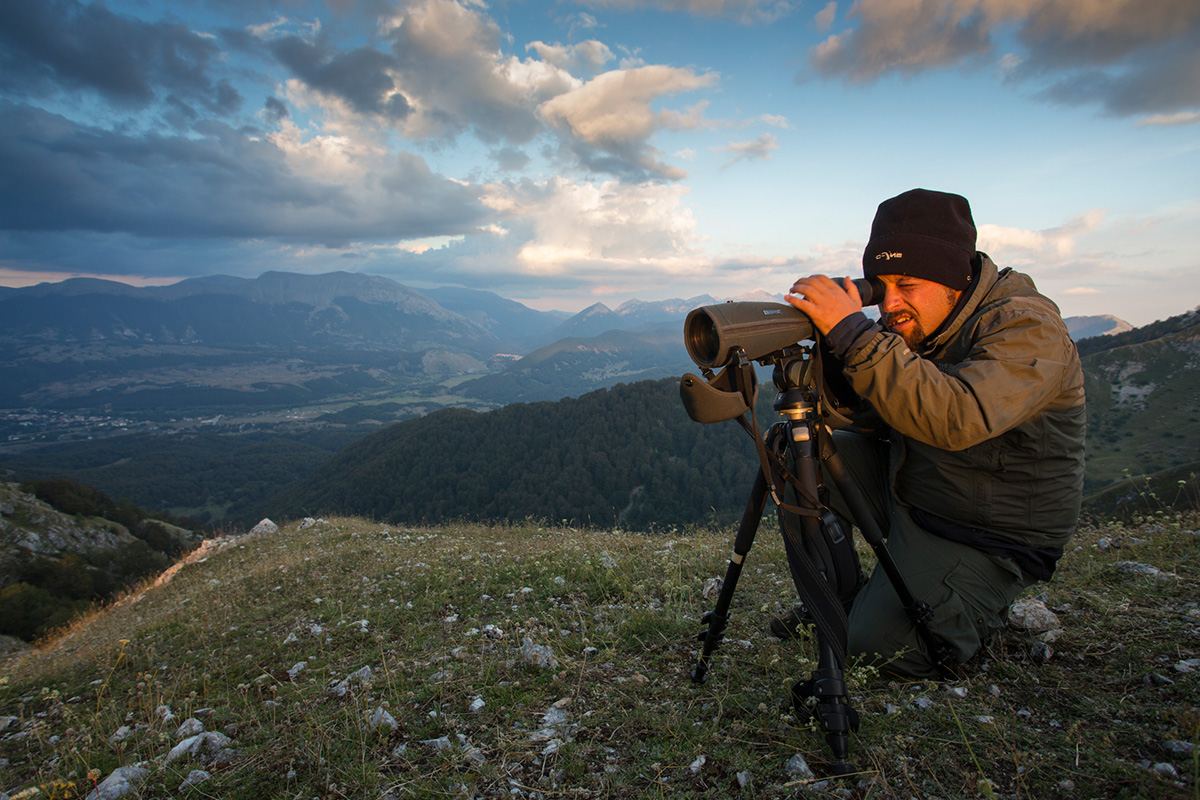
From 2006 to 2007, researchers spent hundreds of hours observing the life of bears in areas of alpine buckthorn scrub.
They use a wide range of facial expressions, body postures and vocalisations to express emotions.
By observing their reactions (from a distance), the researchers were able to interpret the bears’ facial expressions. For a bear, attention to detail is very important, as it takes just a rotation of the ears, or a lip raised to show the teeth, for playful wrestling to turn into an aggressive fight in an instant. An inactive bear, in other words, a bear that is simply resting, walking or feeding, usually has its ears laid back and never looks fixedly at one point. When, on the other hand, it is on the alert, it holds its head up, ears pointed forwards, eyes wide open and mouth closed. While socialising, an animal keeps its ears laid back, opens its mouth and puckers its nose and upper lip. An aggressive or frightened bear lowers its ears along its neck until they almost disappear, closes its mouth and avoids eye contact with the potential rival. If the tension grows to the point of attack, the animal puckers its lips and nose, this time also showing its canines.
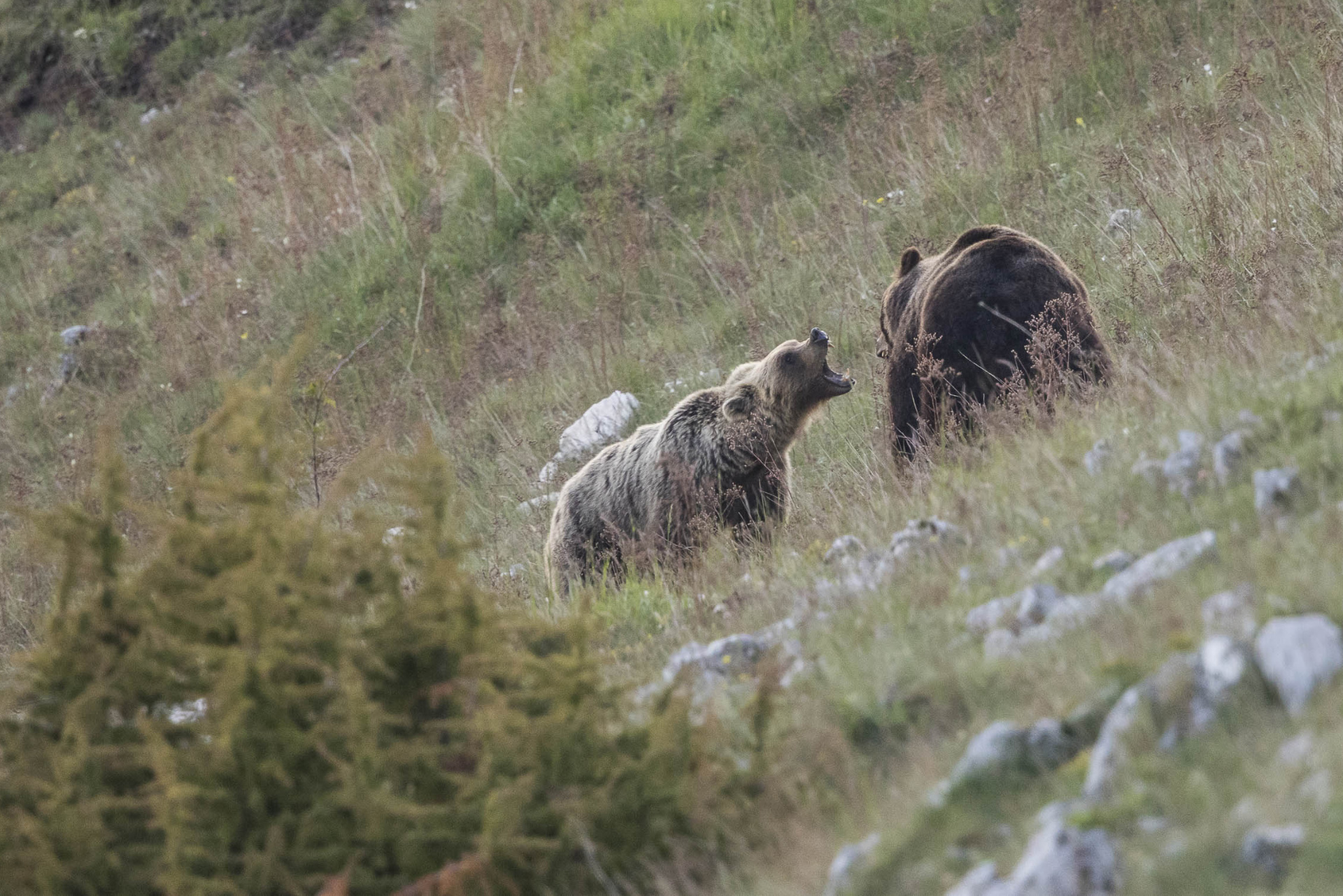
A pair of bears are fighting playfully, but at a certain point the female appears disturbed, lowers her ears and shows her canines to the male.
Bears also convey much clearer messages through their body posture. This enables a dominant to be distinguished from a subordinate.
When a dominant enters the scene, it never goes unnoticed. This often occurs in the alpine buckthorn scrub. A dominant is recognisable by its gait. It advances confidently in the direction of the alpine buckthorn bushes without showing any apparent “emotion”. When it appears, the other bears stop, then either change direction or run away. But if a bear hesitates or lingers too long to observe it, the dominant quickly turns and confronts its rival, stretching out its neck, twisting its nose and flashing its canines. In most cases, the other bear desists and moves or runs away. Whatever the case, a subordinate never shows aggression. It generally assumes a lateral position with respect to the other, drops its head to one side and lets it dangle and sits or lies down. The dominants certainly include the adult males who spend their lifetime competing and establishing hierarchies to secure food and reproductive success. They make their posture even more effective by emphasising their size and physical performance. After the males, it is the females with young cubs that dominate the most, particularly over adolescents and adult males, showing their dominance with a high degree of aggression. On the other hand, females on their own and smaller males tend to avoid or submit to these categories, although they sometimes pick on each other. Among adolescents, the males are the most inexperienced and reckless and are therefore often attacked, while adolescent females are more reserved and almost always shy away from uncomfortable situations.
Two bears interact, re-establishing a mutual hierarchy.
Bears also have their own verbal language. Sounds and vocalisations are very rich, especially between a mother and her offspring.
Right from birth, the cubs make a wide variety of noises and sounds: yelping, whining, grunting, snorting and emitting moaning sounds, together with a distinctive pulsating hum. This hum consists of a very rapid sequence of very short sounds emitted during a prolonged expiratory phase of breathing, interrupted by very short silent inhalations. Production of the sound is associated with body vibrations. This vocalisation is exclusive to bears and not phylogenetically related to any other type of vocalisation known among living carnivores. Its function is unknown. It may be a sign of gratification, or a stimulus to demand milk from the mother. The cubs often seek their mother’s attention by hissing or emitting moaning sounds. The female responds with grunts. When frightened and separated from their mother, the young emit high-pitched calls for help. Adult bears, on the other hand, show tension by snorting and panting during a close encounter with another bear. When very frightened, they snort loudly and gnash their teeth. But during an attack, or aggressive interaction, bears can emit outright roars and growl-like sounds.
Mother and cubs interact with each other both physically and by vocalising. This holds the group together and ensures the survival of the young.
All bears play, not just the cubs. Play is one of the ways bears relate to each other in a non-competitive, risk-free way, regardless of social rank.
Play is a very common social behaviour in the family group, especially between siblings in the same litter. It often seems like a friendly fight. But play has also been observed between yearlings from different litters and between groups of individuals of different ages and genders. Studies have shown that the more cubs under two years of age engage in play, the more likely they are to survive. Intense and prolonged stressful situations, such as interactions with especially aggressive adult bears, can induce chronic stress in inexperienced youngsters. This can lead to excessive physiological activation, pushing the body into a state of physical exhaustion and thus vulnerability. The young bears may waste away to such an extent that they become easy prey, or die of starvation. Developing the ability to interact with others non-competitively can therefore be beneficial for a young bear. For example, resourcefulness, flexibility and the ability to co-operate and coexist with adult bears are qualities that can enable a young bear to remain longer in its home territory. This strategy can be particularly advantageous for young females. Playing is a training ground for life from the very first months. Cubs use it to get fit, learn codes of conduct and behaviour with adults and test their own physical ability as they develop.
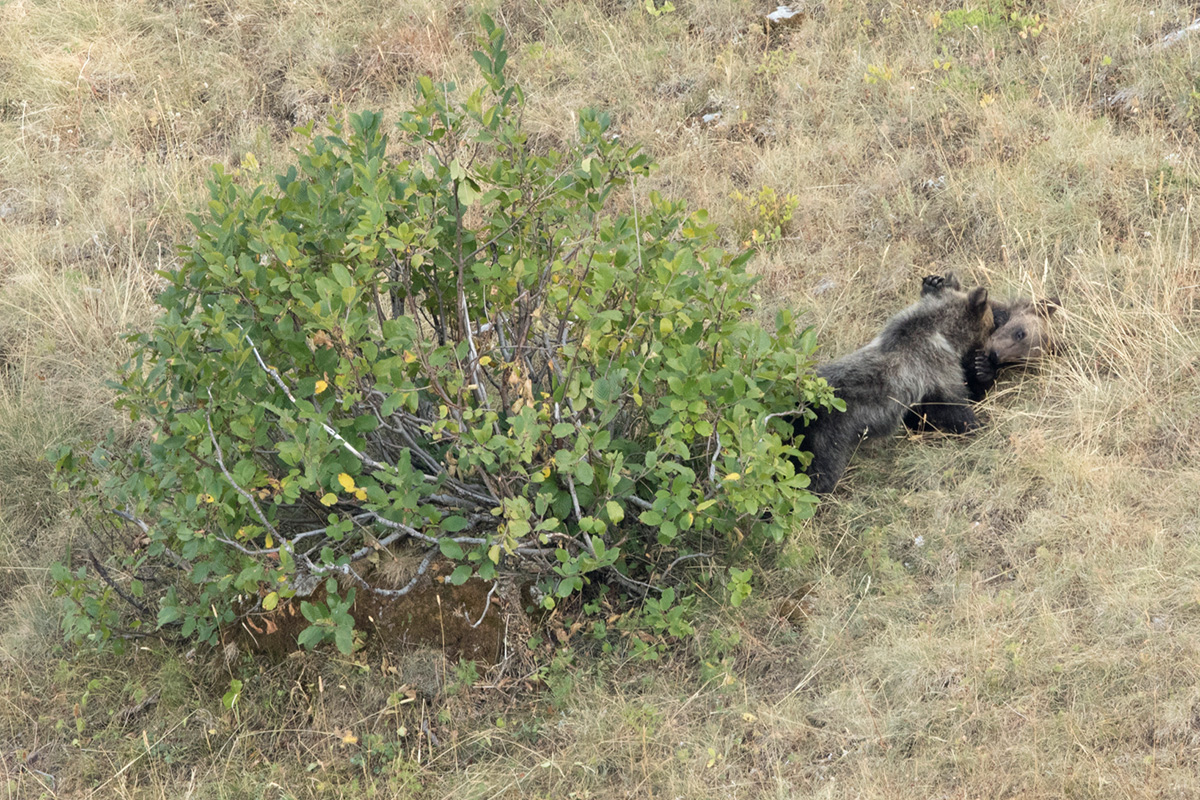
Play between bears resembles a fight in which the roles are often reversed and no one gets hurt.
Play modes and tactics vary between adults and youngsters. Play between individuals of different ages and sexes can help familiarisation, assess the level of kinship and test the physical abilities of potential rivals.
Play follows precise patterns of movement and there is generally no vocalisation. One bear walks up to the other with lips and nose puckered and ears perpendicular to the head and facing downwards. It then opens its mouth and starts giving the other bear light bites and blows with its paws, together with sometimes convulsive head butts. It also rears up on its hind legs. The other bear responds in the same way. When they have finished playing, the bears keep their lips puckered, close their mouths and run away. The fights may be preceded, or followed by, submissive behaviour by one or both bears. Especially during their first year of life, the cubs spend more than half their day playing. But as they grow up, they devote more time to eating. Everyone can take part in the game: mother, brothers and sisters. In adults, it is usually individuals of different ages and ranks that let themselves go in a playful fight. The interaction is usually initiated by the lowest-ranking bear. But during the game, roles change and dominants voluntarily hold themselves back. They submit, do not resist and orient themselves lower than the younger animal. Perhaps a way to prolong the fight and clearly codify that the interaction is entirely friendly.
Researcher Melanie Clapham, from the Department of Geography at the University of Victoria in British Columbia, talks about the results of research into the social behaviour of bears.
Driven by extreme curiosity and intelligence, bears not only play or interact with each other, but also with objects. Bears can also predict and resolve even complex situations.
There is an evolutionary explanation for this. Since the first pioneering studies in the 1950s, researchers have devoted their lives to observing brown and black bears closely in order to understand their intelligence, in other words, their cognitive abilities and thus their understanding of the world around them. Like chimpanzees, bears are able to use tools to solve problems. In experimental studies conducted in captivity, bears are able to place differently shaped objects in the right place to obtain food as a reward. Bears can count and categorise photographs according to content, showing an amazing ability to formulate concepts and make abstractions. In the wild, a bear has been observed making repeated use of stones fished out of the water to scratch and clean its face after feeding on a whale carcass. Anecdotes gathered over the years of monitoring have shown the bears in the Park to be highly intelligent. Some bears, particularly females, have learnt to trigger the nooses used to catch them, sending weeks of preparation up in smoke. The bears have learnt to recognise people in uniform and vehicles and to predict circumstances, defying every strategy deployed to persuade them to move away from the villages. From an evolutionary point of view, the force of selection that fostered development of these cognitive and manipulative skills is the same that enabled bears to become ever more adept at feeding on high-calorie foods and thus sustaining their metabolism and long winter fast. Young bears are without doubt the most curious and every natural and non-natural object is a reason for study, exploration and play.
A young bear that has recently left its mother seems to test its physical abilities by jumping and climbing from tree to tree. But then an unfamiliar object catches its eye. It is amazing how aware this animal is of the change induced in the camera trap after its manipulation.
But in some situations play is not enough and confrontation is inevitable, even though the bears try to avoid direct physical contact right to the end. This happens when their space has been violated, during encounters with a strange bear, when frustrated and in competition for food.
The bears avoid physical contact, by using threatening or conciliatory signals. Clashes are rare and occur when a bear, especially if a stranger, violates another bear’s space, if the loser in a confrontation decides to redirect aggression towards a third bear, or if there is strong competition for the same food (for example, a carcass). In the vicinity of the alpine buckthorn scrub, actual attacks against other bears were only observed in the case of females with cubs. In most cases, bears study, observe and “dialogue” with each other at a distance. When approaching the scrub, subordinate bears sit and wait for the dominant to move away from the feeding area, or if they are feeding, they stop eating and become alert. Alternatively, they may advance towards the other to study or intimidate it. Some bears avoid any kind of interaction, moving around the edge of the scrub, trying to keep as far away from the others as possible. Other bears choose to feed at times when there is less risk of other individuals being present, such as during the day.
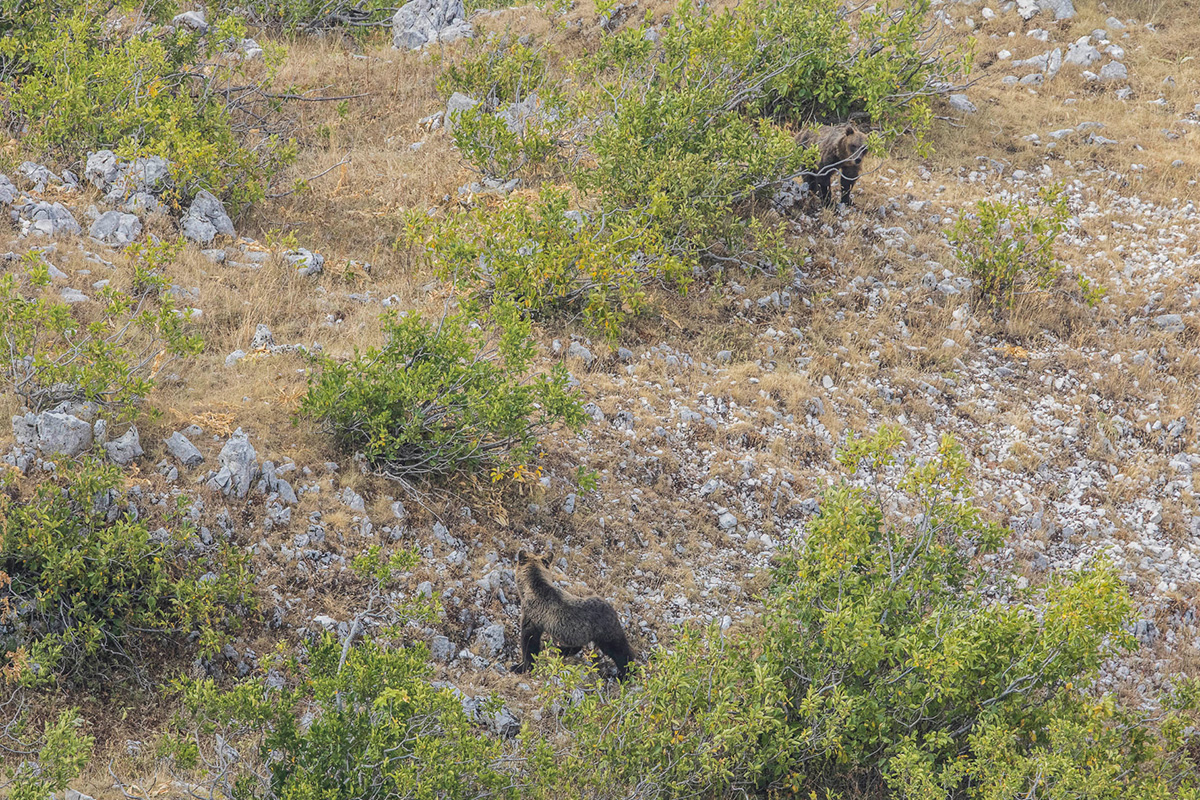
Two bears feed at a distance of about 20 metres. The two animals are aware of each other’s presence, but continue to feed quietly, although they occasionally raise their heads to investigate.
When confrontation is unavoidable, all peaceful tactics are in vain. The two animals face each other directly with their front legs stiff, they lower their heads slightly and begin moving in slow motion. Both bears face each other with their mouths open, exposing their canines. If neither drops back, the attack begins. One or both start charging, head lowered by 30-45 degrees, ears back, mouth slightly open and head and body oriented directly towards the rival. If one of the bears runs away or lies down in the meantime, the attack can be resolved with a bluff. The attack begins with a growl that quickly becomes a loud roar. The bears strike, bite and grab each other with their jaws. Usually the fights end with a winner and a loser who backs down, dropping its head sideways and walking or running away. This type of interaction occurs most frequently between individuals of different sexes and ages and often involves females with young. In the case of individuals of similar rank, especially females, and when defending a food source, the animals confront each other with their heads down and noses pointing to the ground, emitting short, repetitive thunderous growls and exposing their lower canines. They seem undecided whether to move away or interact. Abandoning a carcass or a good alpine buckthorn bush is not an easy choice. The bears may advance or sit on the ground with their heads turned towards the other bear, depending on whether the other bear is acting as a dominant or subordinate. At close range they arch their backs. But this type of interaction rarely culminates in an attack, as one of the bears normally moves away.
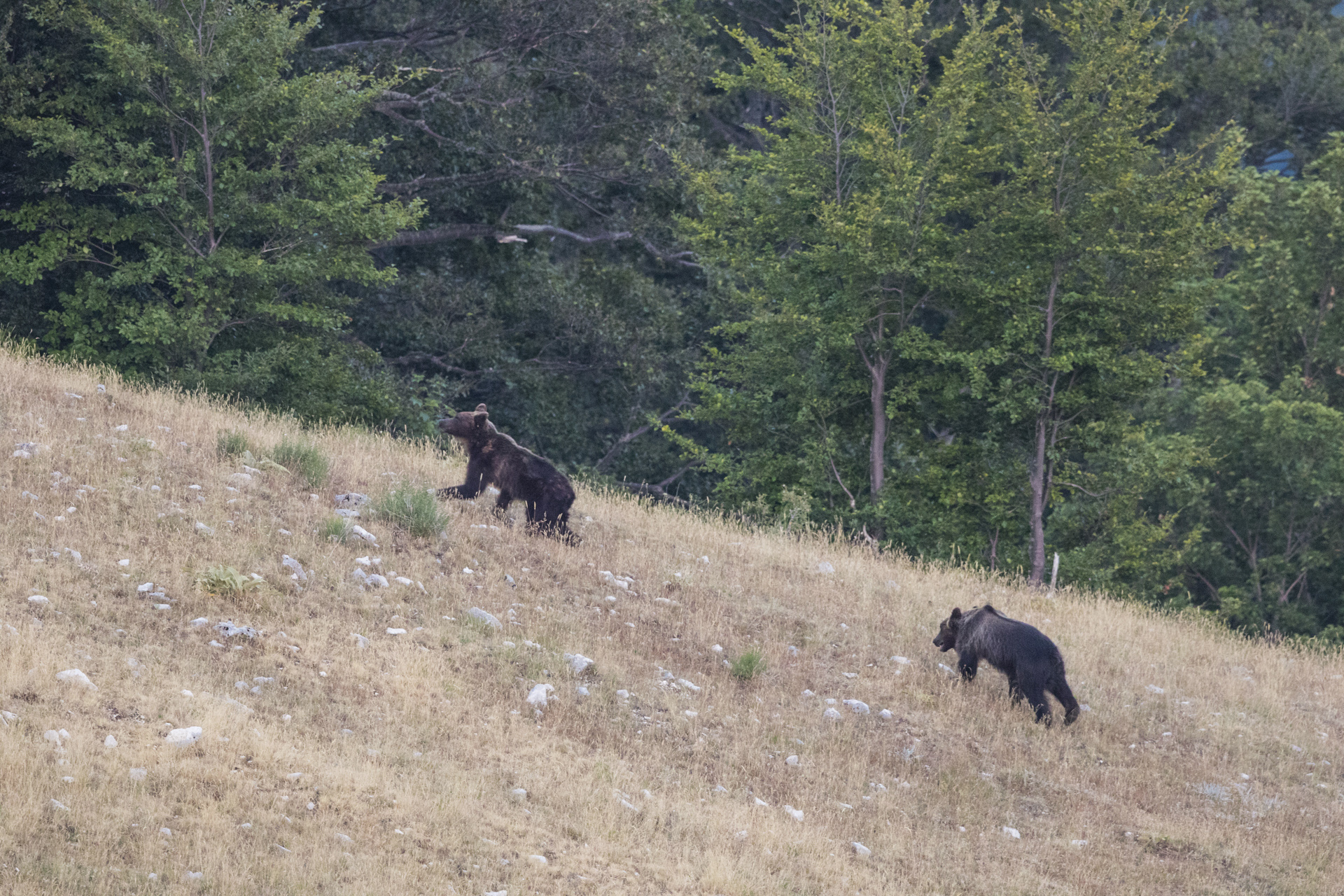
Two bears confront each other aggressively.
Knowing how to read the mood of a bear is also useful for humans to avoid running risks by over-interpreting a danger signal, or confusing a peaceful signal with an attack. A bear that stands up is an alert or curious bear, it is not about to attack. Bears seldom attack, they usually give warning signals, express unease and perform mock charges. The best reaction in all situations is neither to flee, hide, nor attack, but to reveal yourself peacefully and calmly walk away. For humans as for bears, the same rules apply… avoid putting the bear under pressure. Examples include disturbing an individual feeding on a carcass, approaching a female with cubs or a wounded bear, or surprising a bear at close range.
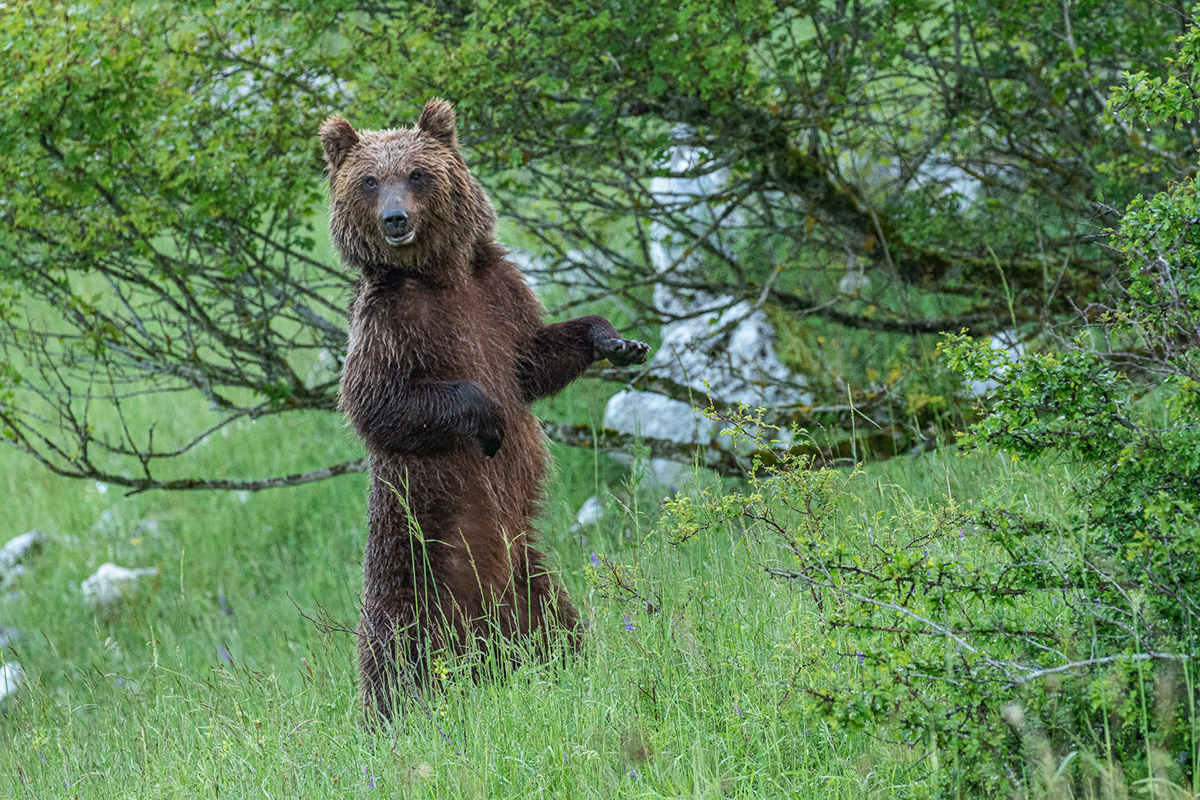
A bear goes on alert to assess whether or not there is imminent danger.
In the Park, the great tolerance always shown by people towards bears is a clear indication that the Apennine bear is neither aggressive nor particularly dangerous. Recent studies on the genomics of this subspecies confirm a meeker disposition than other populations. But it is nevertheless a large wild carnivore, so it is best to keep your distance.

